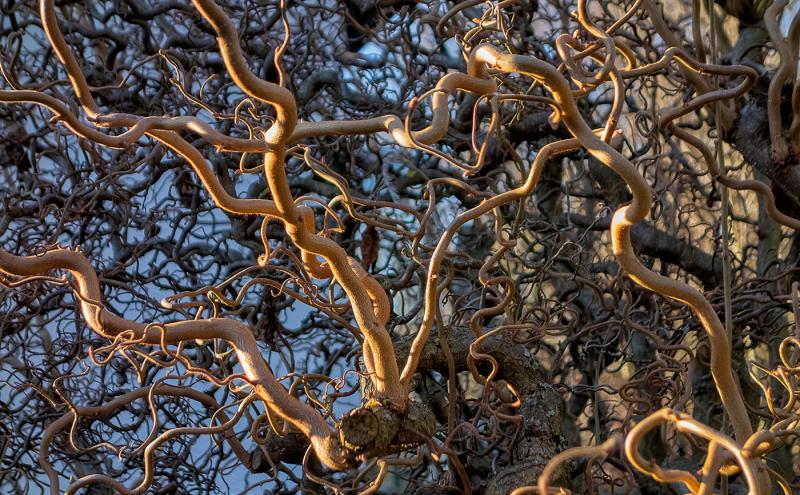Sir Winston Churchill called him "Scotland's greatest ever ambassador," and he was at one time the highest-paid performer in the world. Coal miner-turned-singer Harry Lauder often performed in full Highland regalia – wearing a kilt, sporran and tam-o'-shanter, and carrying his trademark Scottish twisted walking stick.
You can grow your own version of Harry Lauder's Walking Stick (Corylus avellana Contorta), a hardy shrub that is actually a corkscrew hazel with twisted, gnarled branches. This eye-catching plant can grow up to 10 feet tall and is spectacular in all four seasons. In late winter, the bare, brownish-gray branches form a curving sculpture in the yard. Later in winter or early spring, the shrub blooms with long, yellow-green catkins offering some of the first flashes of color in the spring landscape. During the summer, Harry Lauder’s Walking Stick becomes covered with large, drooping green leaves, which turn a dark yellowish-gold in the fall.
Choose a planting spot that gets full sun to partial shade, or grow it in a large container. These shrubs grow best in well-drained soil rich in organic matter such as compost. Poorly draining soil may cause root rot. After planting, add a layer of mulch around the base of the shrub to hold in moisture and keep the roots cool. Once established, water the plants only as they needed; those grown in containers will need watering more often.
Harry Lauder’s Walking Stick is hardy in USDA Zones 4 to 8. It adapts well to both dry and moist locations, and is not particular as to the type of soil or soil pH. It is highly tolerant of urban pollution and even thrives in cities.
You can buy grafted plants or plants grown on their own roots. Own-root plants will not produce suckers the way the understock of grafted plants often will. This shrub can be expected to live for about 30 years. There is a new cultivar called Red Majestic that has burgundy-colored new growth.
By carefully pruning, you can train the plant into a large shrub or even a tree-like form. Because it is a slow-growing plant, prune it very lightly. These carefree shrubs are ideal as single landscape specimens, or use multiples as a spectacular hedge.
Plant them near ponds or stream banks, in rock gardens and along the edges of woodlands. They are great along the edges of patios and walkways, near porches, or anywhere you want visual interest in the yard or garden. Because they are slow-growing and short, you can even plant them under power lines. You can propagate Harry Lauder's Walking Stick in the autumn by layering.
Your plant may even produce some filberts, aka hazelnuts. However, these nuts are often not as tasty as those found on commercial varieties; they are usually left for the squirrels.
Plant Harry Lauder's Walking Stick, and you will have a maze of corkscrew branches to use in cut-flower arrangements or wreaths. It offers lush foliage in the summer and bright flowers in late winter when you need them most, along with the fascinating curves of a gnarled trunk that literally puts a new twist on gardening.





















































